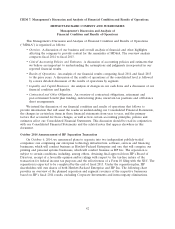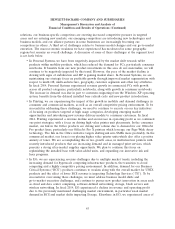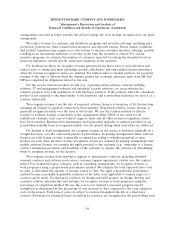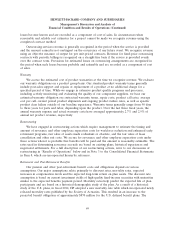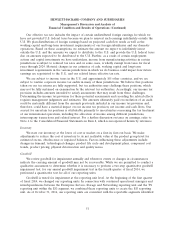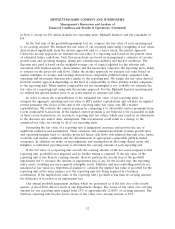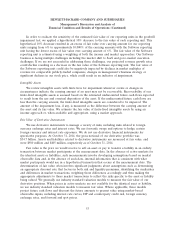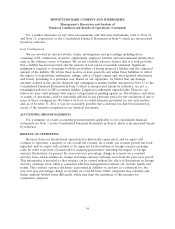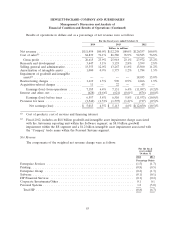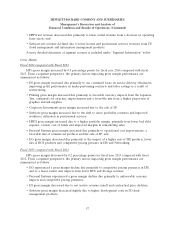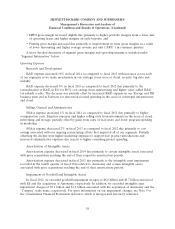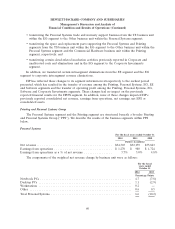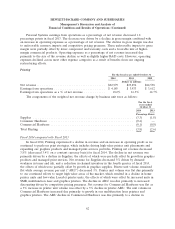HP 2014 Annual Report Download - page 60
Download and view the complete annual report
Please find page 60 of the 2014 HP annual report below. You can navigate through the pages in the report by either clicking on the pages listed below, or by using the keyword search tool below to find specific information within the annual report.HEWLETT-PACKARD COMPANY AND SUBSIDIARIES
Management’s Discussion and Analysis of
Financial Condition and Results of Operations (Continued)
in Note 2, except for ES, which includes two reporting units: MphasiS Limited; and the remainder of
ES.
In the first step of the goodwill impairment test, we compare the fair value of each reporting unit
to its carrying amount. We estimate the fair value of our reporting units using a weighting of fair values
derived most significantly from the income approach and, to a lesser extent, the market approach.
Under the income approach, we estimate the fair value of a reporting unit based on the present value
of estimated future cash flows. Cash flow projections are based on management’s estimates of revenue
growth rates and operating margins, taking into consideration industry and market conditions. The
discount rate used is based on the weighted-average cost of capital adjusted for the relevant risk
associated with business-specific characteristics and the uncertainty related to the reporting unit’s ability
to execute on the projected cash flows. Under the market approach, we estimate fair value based on
market multiples of revenue and earnings derived from comparable publicly-traded companies with
operating and investment characteristics similar to the reporting unit. We weight the fair value derived
from the market approach depending on the level of comparability of these publicly-traded companies
to the reporting unit. When market comparables are not meaningful or not available, we estimate the
fair value of a reporting unit using only the income approach. For the MphasiS Limited reporting unit,
we utilized the quoted market price in an active market to estimate fair value.
In order to assess the reasonableness of the estimated fair value of our reporting units, we
compare the aggregate reporting unit fair value to HP’s market capitalization and calculate an implied
control premium (the excess of the sum of the reporting units’ fair value over HP’s market
capitalization). We evaluate the control premium by comparing it to observable control premiums from
recent comparable transactions. If the implied control premium is not believed to be reasonable in light
of these recent transactions, we reevaluate reporting unit fair values, which may result in an adjustment
to the discount rate and/or other assumptions. This reevaluation could result in a change to the
estimated fair value for certain or all of our reporting units.
Estimating the fair value of a reporting unit is judgmental in nature and involves the use of
significant estimates and assumptions. These estimates and assumptions include revenue growth rates
and operating margins used to calculate projected future cash flows, risk-adjusted discount rates, future
economic and market conditions and the determination of appropriate comparable publicly-traded
companies. In addition, we make certain judgments and assumptions in allocating shared assets and
liabilities to individual reporting units to determine the carrying amount of each reporting unit.
If the fair value of a reporting unit exceeds the carrying amount of the net assets assigned to that
reporting unit, goodwill is not impaired and no further testing is required. If the fair value of the
reporting unit is less than its carrying amount, then we perform the second step of the goodwill
impairment test to measure the amount of impairment loss, if any. In the second step, the reporting
unit’s assets, including any unrecognized intangible assets, liabilities and non-controlling interests are
measured at fair value in a hypothetical analysis to calculate the implied fair value of goodwill for the
reporting unit in the same manner as if the reporting unit was being acquired in a business
combination. If the implied fair value of the reporting unit’s goodwill is less than its carrying amount,
the difference is recorded as an impairment loss.
Our annual goodwill impairment analysis, which we performed as of the first day of the fourth
quarter of fiscal 2014, did not result in any impairment charges. The excess of fair value over carrying
amount for our reporting units ranged from 18% to approximately 12,000% of carrying amounts. The
Software reporting unit has the lowest excess of fair value over carrying amount at 18%.
52


